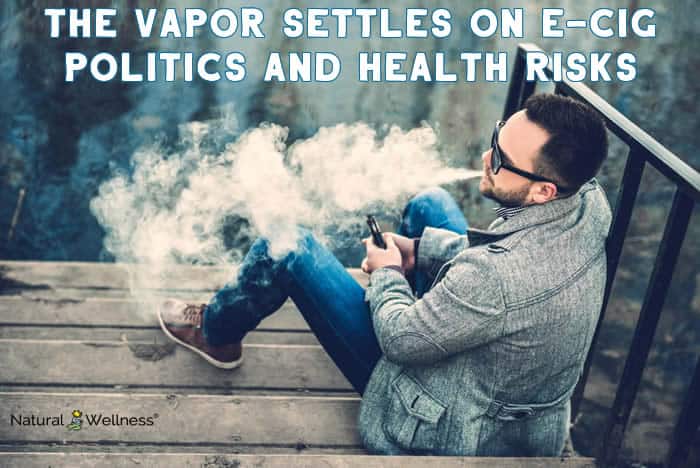

What Is Vaping?
Vaping is the act of using an electronic cigarette to heat a liquid extract, typically derived from nicotine, to the point where it becomes a vapor and can be inhaled. Two different delivery systems exist, open or closed, depending on if users can refill cartridges themselves or not. Most e-liquids, juices, and oils are made with nicotine, propylene glycol, glycerine, and flavorings (4).
Rapid Growth
According to market research group Euromonitor and the BBC, the worldwide vaping market was 7 million people in 2011. Now, with an impressive 19.8% compound annual growth rate, the vaping industry is set to include 55 million people by 2025 (1).
Growth that aggressive makes right now an important moment to understand the health implications and motivations of manufacturers, regulators, and consumers.
Heated Debate
2019 has already seen a wave of e-cig news and controversy after many conservative groups such as Americans for Tax Reform, ALEC Action, the Competitive Enterprise Institute, and the Goldwater Institute ramped up criticism of now resigned FDA Commissioner Scott Gottlieb for taking on “youth vaping” as one of his cornerstone issues (3). By the time you read this article Gottlieb will likely be out of office, but in his final days, the FDA announced new rules that e-cig manufacturers must adhere to if they want to stay on the market.
Advocate groups see vaping as a useful tool in overcoming nicotine addiction and also as a source of innovation and growth for our economy. In a letter sent to the White House early February, these advocate groups criticize the FDA and Gottlieb for their “aggressive regulatory assault” on e-cigarettes (3). For those who have used vaping to overcome their smoking habits, the FDA’s toughening as a perceived attack on the possibility of prescribing vaping to medically treat nicotine addiction.
However, many experts, including Johns Hopkins, Yale, and the U.S. Centers for Disease Control remind us that most e-cigarettes still have nicotine in them which, in any form, is still an incredibly addictive substance. There already exists a vast body of research warning us of the health risks of nicotine and smoking and, while vaping may be less harsh and have fewer chemicals, nicotine still:
- raises your blood pressure
- increases your adrenaline
- speeds heart rate
- and increases the likelihood of cardiovascular disease.
Pair that with the meteoric industry growth and there’s a strong possibility we’re looking at a very tangible public health risk.
The Future Is Hazy

With Scott Gottlied out, the regulatory fate of e-cigarettes and vaping hangs in question. The new FDA proposed guidelines are already being considered by many cities like San Francisco proposing bans and moratoriums to protect its citizens from the perceived threat of vaping. And they’re not the only ones with similar proposals in Florida in an attempt to impede youth and teen adoption.
So whether or not the FDA will ever take a hard stance on e-cigs and vape products, it’s definitely empowered and encouraged states to fight the growth of a potentially harmful industry. Lawyers representing San Francisco, Chicago, and New York have jointly sent a letter to the FDA demanding the “immediate public health review of e-cigarettes” and went so far as to say the FDA “has simply failed to do its job in unprecedented fashion” by allowing e-cigarettes to already be sold without review.
The Hard Science
No matter what the political fate of e-cigs, numerous organizations such as The Academy of Pediatrics, Centers for Disease Control and Prevention, National Academies of Sciences, Engineering and Medicine, and the American Lung Association have all issued warning statements about the risks of vaping and e-cigs.
Current legal pushback on marketing and selling e-cigs to kids and teens remains the primary goal, but the largest question mark in this entire equation stems from vaping and e-cigs being so new that long term data, and thus any associated long-term health risks, don’t exist yet. Sweeter flavors are a duel concern being an irritant that causes inflammation in the airways and simultaneously attracting a younger-skewing demographic.
Many fear the current dynamic is setting the stage for a very plausible reality where usage is increasing rapidly right alongside long term health risks.
Advocates argue that e-cigs and vaping are far less harmful than cigarettes and should be offered in subscription form as a potential treatment for nicotine addiction, but most of the science indicates that nicotine in any form can be harmful, and vaping is not without inhaling its own slew of chemicals and particles, albeit less than an actual cigarette, vaping appears only the slightly less evil of the two. Which leads us to…
5 Healthy Ways to Stop Smoking
While vaping may be helpful for some, it certainly isn’t healthy. So instead of reaching for the e-cig, try using some of the suggestions below on your path to quit.
1.CBD
CBD, or cannabidiol, has many health benefits and doesn’t come with the psychoactive effects commonly associated with smoking marijuana or consuming THC. Research has proven that CBD-derived products such as oils are helpful in reducing anxiety and stress on a daily basis, including during nicotine withdrawal periods. Smaller studies have illustrated CBD’s effectiveness in helping reduce cigarette consumption and as an intervention tool for many addictive behaviors.
2. Counseling
There are many different free and readily available sources for counseling online and in person. One such resource is NoButts.org, offering free telephone counseling as well as self-help materials and practical tips like finding a strong reason you may want to quit for and thinking about that when you have urges. Another helpful tip from Nobutts is mentally categorizing yourself as a non-smoker, and not just a smoker who isn’t currently smoking. This may help you say no in all situations, as opposed to just saying no circumstantially.
3. Quitting Aids

Nicotine patches and gums are healthy, FDA-approved ways to help people quit. Patches and gums curb cravings and withdrawal symptoms and are readily available over the counter. Oral substitutes such as toothpicks or hard candy may also help fight the oral fixation commonly associated with smoking cigarettes.
4. Avoiding Pitfalls
Keep yourself busy if you’re trying to quit. Also, avoid other people who smoke regularly, as well as using other drugs like alcohol which can impair judgment and lead to relapse.
5. Healthy Body, Healthy Mind
Keeping a balanced diet and incorporating exercise into a daily routine is a great way to set you up to succeed at quitting. Working out also releases endorphins, which are your body’s natural pain killers. Endorphins alone make working out a worthwhile endeavor and can help ease withdrawl symptoms.
Conclusion
While vaping may indeed help some quit smoking, the overwhelming data on nicotine consumption and the little we already know about vaping seems to indicate that e-cigs are merely the lesser of two pretty substantial evils. Before trying to quit, make a plan and use the above advice. And remember, it’s never too late.




